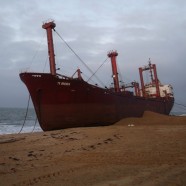The TK Bremen Situation
A Demolition Derby
The demolition of the TK Bremen on French territory is a spectacular example of the administrative simplification so dear to the government. The dumping of this industrial waste amounting to 2,000 tons is containing asbestos in several forms, polychlorinated biphenyl (PCB), hydrocarbon traces, lead paint, mercury and tin are not submitted to French and European control’s temporary authorization for a Classified Facility for the Protection of the Environment. The guidelines of the Bale Convention and the International Maritime Organization on the dismantlement of ships are not being respected. Robin des Bois requests that the prefect of Morbihan, the maritime prefecture, and the labor inspectors publish the map of dangerous waste present on the TK Bremen, if it exists.
Everything about TK Bremen
TK Bremen (ex-Melinau Satu, ex-Melinau, ex-Elm). IMO 8113487. General cargo. Length 109 meters. Maltese flag. Classification society Bureau Veritas. Built in 1982 at Pusan (South Korea) by Dae Sun SB & E Co. her Turkish ship owner Adriyatik GemiIsletmeciligi controls 8 ships, all Maltese-flagged, built between 1982 and 1985. Each of them is officially the property of “single ship company” except in the TK Bremen’s case where it happens to be a “double ship company”, Blue Atlantic Shipping, ltd., also holds the TK London. The financial damages provoked by the drifting and beaching of the TK Bremen are chargeable to this single company based in the European Union at Malta.
Everything about TK Bremen
TK Bremen(ex-Melinau Satu, ex-Melinau, ex-Elm). OMI 8113487. Marchandises diverses. Longueur 109 m. Pavillon Malte. Société de classification Bureau Veritas. Construit en 1982 à Pusan (Corée du Sud) par Dae Sun SB & E Co. Son armateur turc Adriyatik GemiIsletmeciligi contrôle 8 navires, tous sous pavillon maltais, construits entre 1982 et 1985. Chacun d’entre eux est officiellement la propriété de « single ship companies » sauf dans le cas du TK Bremen où il s’agit d’une « double ship company », la Blue Atlantic Shipping, également détentrice du TK London. Les dommages financiers provoqués par la dérive et l’échouage du TK Bremen seront à la charge de cette seule compagnie basée dans l’Union Européenne, à Malte.
A Cargo Ship on the Beach
In referring to Article R 304-11 of the Code of Maritime Ports (1), the Port Authority of the port of Lorient – Morbihan – could have proceeded with the postponement of the departure of the TK Bremen. In effect, this 30 year-old ship had reached the age of demolition. She presented numerous deficiencies. The absence of panels on the entire hold, as was demonstrated before by aerial photos – might be one more of them. The ship had been recently detained in a Russian port and its Turkish ship owner, proprietor of two older ships, did not immediately furnish all of the guarantees of reliability. The profile of the TK Bremen was such that those responsible for the security and of the traffic of the port of Lorient should have, in view of the imminent dangers about to confront them in a dangerous maritime environment rich in marine life, banned its departure.
A Cargo Ship on the Beach
In referring to Article R 304-11 of the Code of Maritime Ports (1), the Port Authority of the port of Lorient – Morbihan – could have proceeded with the postponement of the departure of the TK Bremen. In effect, this 30 year-old ship had reached the age of demolition. She presented numerous deficiencies. The absence of panels on the entire hold, as was demonstrated before by aerial photos – might be one more of them. The ship had been recently detained in a Russian port and its Turkish ship owner, proprietor of two older ships, did not immediately furnish all of the guarantees of reliability. The profile of the TK Bremen was such that those responsible for the security and of the traffic of the port of Lorient should have, in view of the imminent dangers about to confront them in a dangerous maritime environment rich in marine life, banned its departure.










